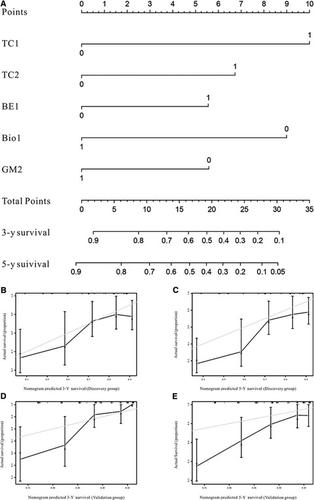当前位置:
X-MOL 学术
›
Cancer Med.
›
论文详情
Our official English website, www.x-mol.net, welcomes your feedback! (Note: you will need to create a separate account there.)
A nomogram to predict outcomes of lung cancer patients after pneumonectomy based on 47 indicators.
Cancer Medicine ( IF 4 ) Pub Date : 2020-01-03 , DOI: 10.1002/cam4.2805 Bo Cheng 1 , Cong Wang 2 , Bing Zou 1 , Di Huang 2 , Jinming Yu 1 , Yufeng Cheng 2 , Xue Meng 1
Cancer Medicine ( IF 4 ) Pub Date : 2020-01-03 , DOI: 10.1002/cam4.2805 Bo Cheng 1 , Cong Wang 2 , Bing Zou 1 , Di Huang 2 , Jinming Yu 1 , Yufeng Cheng 2 , Xue Meng 1
Affiliation

|
AIMS
We aimed to establish a nomogram for lung cancer using patients' characteristics and potential hematological biomarkers.
METHODS
Principle component analysis was used to reduce the dimensions of the data, and each component was transformed into categorical variables based on cutoff values obtained using the X-tile software. Multivariate analysis was used to determine potential prognostic biomarkers. Five components were used in the predictive nomogram. Internal validation of the model was performed by bootstrapping of samples, while external validation was performed on a separate cohort from Shandong Cancer Hospital. The predictive accuracy of the model was measured by concordance index and risk group stratification. Decision curve analysis was performed to evaluate the net benefit of the models.
RESULTS
One hundred patients in the Discovery group and 111 patients in the Validation group were retrospectively analyzed in this study. Forty-seven indexes were sorted into eight subgroups. Five components based on cox regression analysis were enrolled into the predictive nomogram. The nomogram prediction of the probability of 3- and 5-year overall survival was in great concordance with the actual observations. Of interest, the nomogram allowed better risk stratification of patients and better accuracy in predicting patients' survival compared with pathological tumor-node-metastasis staging system.
CONCLUSION
A nomogram was established for prognosis of lung cancer, which can be used for treatment selection and clinical care management.
中文翻译:

根据47项指标预测肺切除术后肺癌患者预后的列线图。
目的我们旨在利用患者的特征和潜在的血液生物标志物建立肺癌的诺模图。方法使用主成分分析来减少数据的维数,并且根据使用X-tile软件获得的临界值将每个成分转换为分类变量。多变量分析用于确定潜在的预后生物标志物。预测列线图中使用了五个成分。通过对样品进行自举对模型进行内部验证,而对来自山东省肿瘤医院的独立队列进行外部验证。该模型的预测准确性通过一致性指数和风险组分层来衡量。进行决策曲线分析以评估模型的净收益。结果本研究回顾性分析了发现组的100例患者和验证组的111例患者。47个索引分为八个子组。将基于Cox回归分析的五个成分纳入预测列线图中。3年和5年总生存概率的列线图预测与实际观察结果非常一致。有趣的是,与病理性肿瘤淋巴结转移分期系统相比,列线图可以更好地对患者进行风险分层,并可以更好地预测患者的生存。结论建立了诺模图用于肺癌的预后,可用于治疗选择和临床护理管理。47个索引分为八个子组。将基于Cox回归分析的五个成分纳入预测列线图中。3年和5年总生存概率的列线图预测与实际观察结果非常一致。有趣的是,与病理性肿瘤淋巴结转移分期系统相比,列线图可以更好地对患者进行风险分层,并可以更好地预测患者的生存。结论建立了诺模图用于肺癌的预后,可用于治疗选择和临床护理管理。47个索引分为八个子组。将基于Cox回归分析的五个成分纳入预测列线图中。3年和5年总生存概率的列线图预测与实际观察结果非常一致。有趣的是,与病理性肿瘤淋巴结转移分期系统相比,列线图可以更好地对患者进行风险分层,并可以更好地预测患者的生存。结论建立了诺模图用于肺癌的预后,可用于治疗选择和临床护理管理。3年和5年总生存概率的列线图预测与实际观察结果非常一致。有趣的是,与病理性肿瘤淋巴结转移分期系统相比,列线图可以更好地对患者进行风险分层,并可以更好地预测患者的生存。结论建立了诺模图用于肺癌的预后,可用于治疗选择和临床护理管理。3年和5年总生存概率的列线图预测与实际观察结果非常一致。有趣的是,与病理性肿瘤淋巴结转移分期系统相比,列线图可以更好地对患者进行风险分层,并可以更好地预测患者的生存。结论建立了诺模图用于肺癌的预后,可用于治疗选择和临床护理管理。
更新日期:2020-01-04
中文翻译:

根据47项指标预测肺切除术后肺癌患者预后的列线图。
目的我们旨在利用患者的特征和潜在的血液生物标志物建立肺癌的诺模图。方法使用主成分分析来减少数据的维数,并且根据使用X-tile软件获得的临界值将每个成分转换为分类变量。多变量分析用于确定潜在的预后生物标志物。预测列线图中使用了五个成分。通过对样品进行自举对模型进行内部验证,而对来自山东省肿瘤医院的独立队列进行外部验证。该模型的预测准确性通过一致性指数和风险组分层来衡量。进行决策曲线分析以评估模型的净收益。结果本研究回顾性分析了发现组的100例患者和验证组的111例患者。47个索引分为八个子组。将基于Cox回归分析的五个成分纳入预测列线图中。3年和5年总生存概率的列线图预测与实际观察结果非常一致。有趣的是,与病理性肿瘤淋巴结转移分期系统相比,列线图可以更好地对患者进行风险分层,并可以更好地预测患者的生存。结论建立了诺模图用于肺癌的预后,可用于治疗选择和临床护理管理。47个索引分为八个子组。将基于Cox回归分析的五个成分纳入预测列线图中。3年和5年总生存概率的列线图预测与实际观察结果非常一致。有趣的是,与病理性肿瘤淋巴结转移分期系统相比,列线图可以更好地对患者进行风险分层,并可以更好地预测患者的生存。结论建立了诺模图用于肺癌的预后,可用于治疗选择和临床护理管理。47个索引分为八个子组。将基于Cox回归分析的五个成分纳入预测列线图中。3年和5年总生存概率的列线图预测与实际观察结果非常一致。有趣的是,与病理性肿瘤淋巴结转移分期系统相比,列线图可以更好地对患者进行风险分层,并可以更好地预测患者的生存。结论建立了诺模图用于肺癌的预后,可用于治疗选择和临床护理管理。3年和5年总生存概率的列线图预测与实际观察结果非常一致。有趣的是,与病理性肿瘤淋巴结转移分期系统相比,列线图可以更好地对患者进行风险分层,并可以更好地预测患者的生存。结论建立了诺模图用于肺癌的预后,可用于治疗选择和临床护理管理。3年和5年总生存概率的列线图预测与实际观察结果非常一致。有趣的是,与病理性肿瘤淋巴结转移分期系统相比,列线图可以更好地对患者进行风险分层,并可以更好地预测患者的生存。结论建立了诺模图用于肺癌的预后,可用于治疗选择和临床护理管理。



























 京公网安备 11010802027423号
京公网安备 11010802027423号